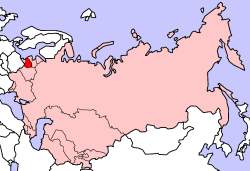Lithuanian Soviet Socialist Republic
| Lietuvos Tarybų Socialistinė Respublika (Lithuanian) Литовская Советская Социалистическая Республика (Russian) Lithuanian Soviet Socialist Republic |
|||||
|
|||||
|
|||||
 |
|||||
| Capital | Vilnius | ||||
| Official language | Lithuanian and Russian | ||||
| Established In the USSR: - Since - Until |
July 21, 1940 August 3, 1940 March 11, 1990 |
||||
| Area - Total - Water (%) |
Ranked 11th in the USSR 65,200 km² negligible |
||||
| Population - Total - Density |
Ranked 11th in the USSR 3,689,779 (1989) 56.6/km² |
||||
| Time zone | UTC + 3 | ||||
| Anthem | Anthem of Lithuanian SSR | ||||
| Medals | |||||
The Lithuanian Soviet Socialist Republic (Lithuanian: Lietuvos Tarybų Socialistinė Respublika; Russian: Литовская Советская Социалистическая Республика Litovskaya Sovetskaya Sotsalisticheskaya Respublika), also known as the Lithuanian SSR for short, was one of the republics that made up the former Soviet Union. It was established after Soviet Occupation of Lithuania in 1940 and existed to 1990 (although there was a failed attempt to establish government in Lithuania by Bolshevik military force in 1918-1919).
Contents |
History
World War I
The Lithuanian SSR was first proclaimed on December 16, 1918, by the provisional revolutionary government of Lithuania, formed entirely by the Communist Party of Lithuania. Lithuanian SSR was supported by Soviet armed forces, but it failed to create a de facto government with any popular support, contrary to the Council of Lithuania. Two months later on February 27, 1919, it was joined by the Soviet Socialist Republic of Byelorussia to form the Lithuanian–Belorussian Soviet Socialist Republic (LBSSR or Litbel), which existed for only six months, until August 25, 1919. Russian Soviet Federated Socialist Republic officially recognized the Republic of Lithuania by signing the Soviet–Lithuanian Peace Treaty on July 12, 1920. It has been suggested that losing the Polish–Soviet War prevented the Soviets from invading Lithuania and re-establishing a Soviet republic.[1][2]
World War II and occupation
Later, the Molotov-Ribbentrop Pact of (August 1939), between Nazi Germany and the Soviet Union, stated that Lithuania was to be included into the German "sphere of influence", but after the World War II broke out in September 1939 was amended to transfer Lithuania to the Soviet sphere in exchange for Lublin and parts of the Warsaw province of Poland, originally ascribed to the Soviet Union, but by that time already occupied by German forces. The Lithuanian Soviet Socialist Republic was established on July 21 1940 (after communist rule was forced upon Lithuania following the Soviet invasion of June 15 1940). On August 3, 1940, a communist government, which had been hastily formed, announced that the Lithuanian SSR would become a part of the Soviet Union, i.e. the 14th constituent republic of the USSR. Its territory was subsequently invaded and occupied by Nazi Germany in 1941, but with the German reverse of its military fortunes and eventual retreat, Soviet rule was re-established there in July 1944.

Legal status
The United States, United Kingdom, and other western powers considered the occupation of Lithuania by the USSR illegal, citing the Stimson Doctrine, in 1940, but recognized all borders of the USSR at post-World War II conferences. In spite of this, the United States refused to recognize the annexation of Lithuania or the other Baltic States, by the Soviet Union, at any time of the existence of the USSR.
In addition to the human and material losses suffered due to war, several waves of deportations affected Lithuania. During the mass deportation campaign of June 14-18, 1941, about 12,600 people were deported to Siberia without investigation or trial, 3,600 people were imprisoned, and more than 1,000 were killed.[3] After the Lithuanian SSR was re-established in 1944, an estimated 120,000 to 300,000 Lithuanians were either killed or deported to Siberia and other remote parts of the Soviet Union.[3]
The Lithuanian SSR was renamed the Republic of Lithuania again, and on March 11, 1990, all legal ties of sovereignty were cut with the Soviet Union as Lithuania declared the restitution of its independence. The government of the USSR recognised Lithuania's independence on September 6, 1991.
Economy
In comparison with other parts of the USSR its economy fared better and today Lithuania remains one of the wealthiest of the formerly Soviet-controlled states.
The economy in Lithuania was relatively good. During Stalin's purges starvation was relatively low. Most people had food and water, and many people were able to obtain economic prosperity. The average standard of living was high.
There was economic downturn when Khrushchev came to power and instigated his reforms. Lithuania faced economic downturn unseen anywhere else in the Soviet Union. However the Lithuanians still fared quite well. They were untied, leading to their relative prosperity now. They were the first nation to leave the USSR and during occupation were the nation which had the largest amount of youth resistance groups and largest number of strikes.[4]
In popular culture
A minor planet 2577 Litva discovered in 1975 by a Soviet astronomer Nikolai Stepanovich Chernykh is named after the Lithuanian Soviet Socialist Republic.[5]
See also
References
- ↑ Snyder, Timothy (2004). The Reconstruction of Nations: Poland, Ukraine, Lithuania, Belarus, 1569–1999. Yale University Press. pp. 62–63. ISBN 030010586X. http://books.google.com/books?id=xSpEynLxJ1MC&pg=PA63&sig=ACfU3U2H_nQ_8H2AF0TrftErYmJzAE1XSw#PPA62,M1.
- ↑ Senn, Alfred Erich (September 1962). "The Formation of the Lithuanian Foreign Office, 1918–1921". Slavic Review 3 (21): 500–507. ISSN 0037-6779.
- ↑ 3.0 3.1 "Background Note: Lithuania". United States Department of State (2008). Retrieved on 2008-05-08.
- ↑ The Baltic States: Estonia, Latvia and Lithuania by David James Smith P. 145
- ↑ Dictionary of Minor Planet Names - p. 210
External links
|
||||||||||
|
||||||||||||||



